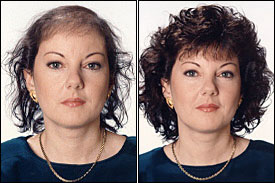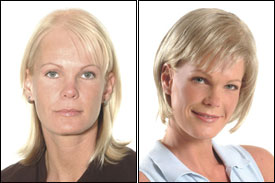Female Pattern Hair Loss
The most common type of hair loss seen in women is Androgenetic Alopecia, also known as female pattern alopecia or baldness. This is seen as hair thinning predominantly over the top and sides of the head. It affects approximately one-third of all susceptible women, but is most commonly seen after menopause, although it may begin as early as puberty. Normal hair loss is approximately 100-125 hairs per day. Fortunately these hairs are replaced. True hair loss occurs when lost hairs are not re-grown or when the daily shed exceeds 125 hairs. Genetically, hair loss can come from either side of the family.
There are two different types of hair loss, medically known as Anagen Effluvium and Telogen Effluvium. Anagen Effluvium is generally due to internally administered medications, such as chemotherapy agents, that poison the growing hair follicle. Telogen Effluvium is due to an increased number of hair follicles entering the resting stage.
The most common causes of Telogen Effluvium are:
- Physical stress from surgery, illness, anemia, rapid weight change.
- Emotional stress from mental illness, death of a family member.
- Thyroid abnormalities.
- Medications, such as high doses of Vitamin A, Blood Pressure medications, and Gout medications.
- Hormonal causes, such as pregnancy, birth control pills, and menopause.
When above causes of Telogen Effluvium are reversed or altered you should see the return of normal hair growth.
Diet Considerations
Hair loss may also occur due to dieting. Franchised diet programs which are designed or administered under the direction of a physician with prescribed meals, dietary supplements, and vitamin ingestion have become popular. Sometimes the client is told the vitamins are a necessary part of the program to prevent hair loss associated with dieting. However, the vitamins cannot prevent hair loss associated with rapid weight loss. Furthermore, many of these supplements are high in Vitamin A which can magnify hair loss.
Physical and Emotional Stress
Surgeries, severe illness, and emotional stress can cause hair loss. The body simply shuts down production of hair during periods of stress since it is not necessary for survival, and instead, devotes its energies toward repairing vital body structures. In many cases there is a three month delay between the actual event and the onset of hair loss. Furthermore, there may be another three month delay prior to the return of noticeable hair re-growth. This then means that the hair loss and re-growth cycle can last six months or possibly longer when induced by physical or emotional stress. There are some health conditions which may go undetected that can contribute to hair loss. These include anemia or low blood count, and thyroid abnormalities. Both of these conditions can be detected by a simple, inexpensive blood test.
Hormonal Consideration
Hormonal changes are a common cause of female hair loss. Many women do not realize that hair loss can occur after pregnancy or following discontinuation of birth control pills. It is important to remember that the hair loss may be delayed by three months following the hormonal change and another three months will be required for new growth to be fully achieved.
Myths Related to Hair Loss
- Frequent shampooing contributes to hair loss.
- Hats and wigs cause hair loss.
- 100 strokes of the hair brush daily will create healthier hair.
- Permanent hair loss is caused by perms, colors, and other cosmetic treatments.
- Women are expected to develop significantly thicker hair.
- Shaving your head will cause the hair to grow back thicker.
- Standing on one’s head will cause increased circulation and thereby stimulate hair growth.
- Dandruff causes permanent hair loss.
- There are cosmetic products that will cause the hair to grow thicker and faster.
- Stress causes permanent hair loss.
- Hair loss does not occur in the late teens or early twenties.
- Hair loss affects only intellectuals.
- There is a cure for Androgenetic Alopecia.
These are only a few of the common myths heard by physicians and other hair loss specialists on a daily basis. The AHLC (American hair Loss Council) suggests that you first have your hair loss diagnosed by a competent dermatologist who sees hair loss patients on a regular basis. Once you know the diagnosis you will have a better understanding of exactly which treatment option may be best for you.
Treatment Options
- Accepting and learning to live with hair loss. Professional counseling may be of help.
- Perms, color, and other cosmetic options to give a fuller appearance to hair.
- Medical Therapy: Rogaine (topical minoxidil). Rogaine is the only FDA approved medication cureently available for female pattern hair loss.
- Hair Replacement Surgery: Modern techniques have made transplantation for females a viable treatment option, providing they are qualified candidates and have realistic expectations.
- Hair Additions: Modern forms of hair additions have also made recent improvements in stimulating a natural appearance. A consultation with a skilled specialist to discuss your options is advised.
Alopecia
Androgenetic Alopecia,the modern medical term for either male or female hair pattern loss, can be broken down into two parts:
1. Androgenetic, consisting of ANDROGEN (any of the various hormones that control the appearance and development of masculine characteristics such as testosterone), and GENETIC (the inheritance of genes from either side of the family). Add age, which when coupled with genetics, represents a time clock that will signal the hair follicle to produce an enzyme called 5-alpha reductase when the testosterone present in the follicle combines with the enzyme 5 (DHT). Hair follicle receptors are sensitive to DHT and thereby start the process of male or female pattern hair loss.
2. Alopecia, meaning hair loss of which there are many types.
Put simply, scientists are working against aging, hormones, and genetics. This is no easy task.
Add the fact that male or female pattern hair loss is not life threatening, and it is easy to see why many physicians do not view hair loss as a priority in scientific research. What is working for you in terms of research is that large pharmaceutical firms now know that a cure for hair loss could mean a fortune in revenue for their companies and stockholders. This is fuel enough and the race has begun.
Although we may not see a cure in our lifetime, it is possible
. Science is closer to understanding hair loss due to many recent advancements. To say the cure is around the corner would only be speculation, but hope is certainly alive.
Since there are other causes of hair loss, it is advisable to consult with a dermatologist who is competent and experienced with diagnosing hair loss. Confirming the type of hair loss you have will make it possible for you to know which treatment options may be best for you.
Other Causes:
Alopecia Areata: Generally thought to be an autoimmune disorder, it causes patchy hair loss, often in small circular areas in different locations of the scalp.
Alopecia Totalis: Total hair loss of the scalp (an advanced form of Alopecia Areata).
Alopecia Universalis: Hair Loss of the entire body (also and advanced form of Alopecia Areata).
Traction Alopecia: Hair loss caused by physical stress and tension on the hair such as prolonged use of hair weaving, corn rows, etc. Done too tightly on weak hair this type of styling can cause permanent hair loss.
Telogen Effluvium: Usually temporary hair loss. Causes: Physical stress, emotional stress, thyroid abnormalities, medications and hormonal causes normally associated with females.
Anagen Effluvium: Generally due to internally administered medications, such as chemotherapy agents, that poison the growing hair follicle.
All of these represent only a few of the different types of hair loss. However, Androgenetic Alopecia represents close to 95% of all hair loss.
Treatments Options Available For Androgenetic Alopecia:
- Learning to live with hair loss. Often the assistance of a professional counselor can be helpful in coping.
- Hair styling and cosmetic techniques such as permanent waves and hair colors. The proper haircut alone can make a vast difference.
- Rogaine, the only FDA approved topical treatment for male or female pattern hair loss. Although Rogaine is not effective in stimulating new hair growth in many males, it appears to be more effective in retarding hair loss in a substantial amount of both males and females.
- Hair additions have made many advances in both appearance and more secure attachment methods. Hair replacement surgery has also made many advances toward more natural appearing results.
- A combination of hair additions with hair replacement surgery.
Chemotherapy
Chemotherapy Related Hair Loss
Chemotherapy is the administration of drugs that destroy rapidly reproducing cells. Cancer cells are some of the most rapidly reproducing cells in the body, but other cells, such as those which contribute to the formulation of hair shafts and nails, are also rapidly reproducing. Unfortunately, while chemotherapy drugs destroy cancer cells, the drug also can destroy those cells responsible for normal growth of hair and nails. Cancer patients sometimes shed their hair and nails during treatment. Chemotherapy drugs are poisonous to the cells of the hair root responsible for hair shaft formation. Sometimes the hair is lost rapidly in large quantities during treatment. No hair growth stimulants, shampoos, conditioners, or other cosmetic treatments can prevent or retard hair loss. The good news, however, is that once chemotherapy is completed, the hair usually grows back.
How and When Hair Growth Occurs
Adequate hair growth may take six months to a year.
- Returning hair may be different from the hair that was lost. Due to the absence or alteration of pigment the hair may grow back white, gray, or a different color. Eventually, as the pigment cells return to normal, the original color should return.
- It is common for the new hair growth to be finer in texture initially, but like color, the texture should return to its original thickness.
It is sometimes difficult to be patient, but as the body is returning to normal and recovering from the physically taxing treatment, time is a necessary ingredient.
Hair Care Tips for New Hair Growth
- Shampoo hair twice weekly with a mild shampoo such as those intended for dry or damaged hair. The scalp should be thoroughly massaged to remove any scale.
- Follow shampoo with a conditioner for fine or limp hair.
- Avoid using blow dryers; the intense heat can damage the hair and skin.
- Keep hairstyling, such as brushing, combing, pinning, and curling to a minimum due to the new hair being prone to breakage. Curling appliances should be avoided as the scalp is very tender following chemotherapy.
- Hair styling aids such as mousse, hair spray, hair spritz, styling gel, and sculpturing gel may be used in moderation. It is best to select products with normal to light holding ability as the high hold products may not be completely removed with mild shampoos. Hair styling aids can build up on the hair shaft resulting in dullness and possibly scalp disease.
Chemical Curling or Permanent Waving
Chemical curling or permanent waving of the hair is best avoided until the hair is at least three inches long. It is difficult to get nice curls if the hair is much shorter even with a healthy head of hair. For best results use a mild body wave with short processing time. The hair should be wrapped loosely on the largest sized curling rod possible. Looser curls will be less damaging to the recovering hair shaft, and will thus minimize hair shaft breakage.
WARNING
Many patients cannot tolerate the permanent wave solution on their scalp for up to one year following chemotherapy. This extreme sensitivity is not unusual during the re-growth period. In such cases permanents should not be attempted.
Hair coloring may also be irritating to the sensitive scalp and should be avoided until the scalp is healed. Permanent hair colorings are the most damaging to the hair shaft and should be minimized in favor of semi-permanent hair colorings, which are gradually washed away with four to six shampoos.
Bleaching to lighten the hair color should not be attempted at this time. Additionally, the hair should be altered only three shades from its re-growth color as more drastic color changes could increase hair shaft breakage.
This period of time following chemotherapy treatment is a time of healing and rebuilding for the body. Hair growth will gradually return, and with time most patients regain a healthy head of hair. Following some of the hair care tips covered here will ensure that the re-grown hair looks and feels its very best.
Children
A word of caution to parents with children undergoing chemotherapy: The absence of hair can be used in a positive manner. It can signal to others “handle with care” because while undergoing chemotherapy the child has a low blood count and can be bruised easily.
The insistence of parents, although well-meaning, for a child to wear a wig or prosthesis can signal the message that they’re not okay the way they are. A child should have all of the options, but the choice should be his or hers. Hugs and tender loving care are all that is necessary from the parents.
In addition to hair loss solutions for men and women, American Image also does custom work for children.
Treatment Options
At the onset of hair loss (the very first hair fall), some patients choose to shave the total scalp. Their reasons are the following:
- The elimination of uncontrolled hair fall and embarrassing shedding.
- Some, especially males, feel that total baldness is more attractive than the spotty hair loss. Many believe that after 25-50 percent hair loss, males or females look healthier with no hair at all.
- Shaving facilitates prosthetic hair security and comfort (i.e. Vacuum bases, two-way tape, and other adhesives for hair prostheses). What may seem extreme to some, may not be for others.
- Attractive head coverings are available from a variety of manufacturers as an alternative to wigs.
Hair Prostheses
- Insurance sometimes covers a wig or prostheses.
- Assume you will lose all of your hair when you begin chemotherapy treatment. By doing so your advance planning will assist you considerably. (Custom-made wigs and hair prosthetic may take six weeks to four months to be made and delivered.)
- Your first wig or hair prosthesis should duplicate your own hair as closely as possible. (Be conservative in color, length, thickness, and style.)
- In chemotherapy related hair loss avoid the following: weaves, hair extensions, hair integrations, and intensifiers. You will need a full prosthesis and not a partial hairpiece.






